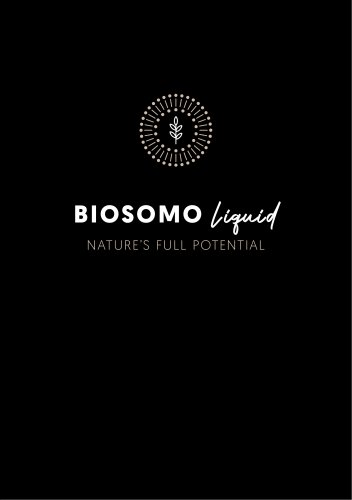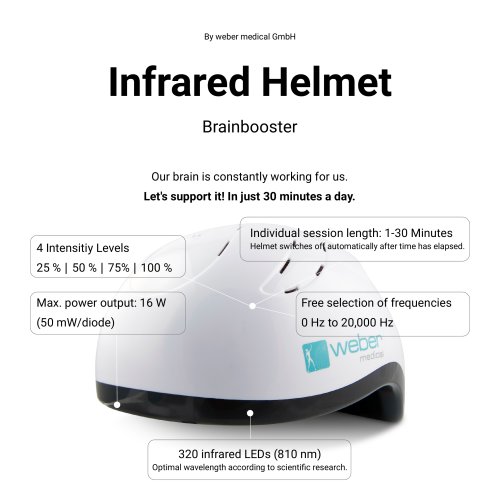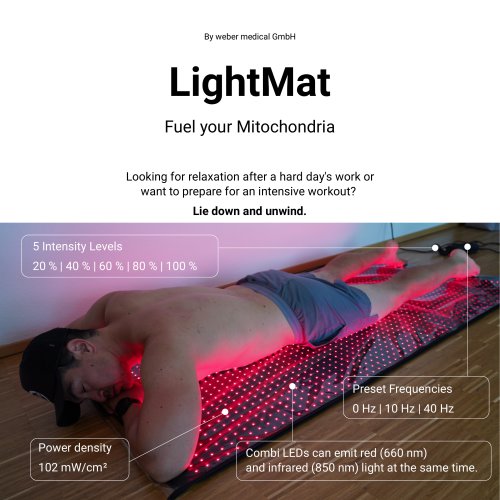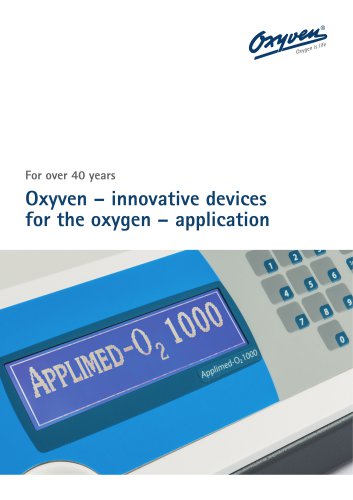 Website:
Weber Medical
Website:
Weber Medical
Catalog excerpts

Dr. med. Dipl. Chem. Michael Weber Weber Medical GmbH Sohnreystr. 4 37697 Lauenförde Germany info@webermedical.com / www.webermedical.com + 49 5273 367780 LED Infrared Helmet Weber Medical
Open the catalog to page 1
LED Infrared Helmet - Product Description Transcranial Low-Level Laser Therapy (TLLLT) – Basics Molecular Mechanisms General Studies of TLLLT for: • • Traumatic Brain Injuries (TBI) Clinical Observations LED Helmet • Volkmar Kreisel, MD (Bietigheim-Bissingen, Germany) James Laporta, MD (Cape Town, South Africa) Michael Ellenburg, ND, MPH, LAc (Anchorage, USA) Additional clinical observations Published Study on LED Helmet by Prof, PhD, MSc, MDsc Gerhard Litscher Order Information Weber Medical GmbH
Open the catalog to page 2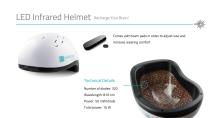
Recharge Your Brain! Comes with foam pads in order to adjust size and increase wearing comfort Technical Details Number of diodes: 320 Wavelength: 810 nm Power: 50 mW/diode Total power: 16 W
Open the catalog to page 3
Easy Handling Treatment time: 1-30 minutes Recommendation: 15-30 minutes (1-2x per day) 4 Intensity levels (25-50-75-100%)
Open the catalog to page 4
Comes with an US adapter Simple Setup
Open the catalog to page 5
Transcranial Low-Level Laser Therapy Transcranial Low-Level Laser Therapy (TLLLT) is the direct irradiation of the human brain with highly focused infrared lasers. Unlike other wavelengths, infrared light has the ability to penetrate bones and to bring light energy to the targeted brain areas. Light energy is absorbed by different types of cells to trigger a broad range of intra-cellular effects. Why infrared light? LED therapy is non-invasive, painless and non-thermal. The optimum wavelength for max. skull penetration is between 805 nm and 830 nm (infrared). Studies show that the light...
Open the catalog to page 6
How PBM affects cellular activity in the brain Stimulation of the mitochondrial respiratory chain (cytochrome c oxidase) Release of NO by photodissociation vasodilatory effects Brief increase in reactive oxygen species Improves lymphatic flow = Increased cerebral blood flow Activation of beneficial cellular pathways Stimulates cytoprotective, anti-oxidant and anti-apoptotic effects in cells Improved oxygen availability and oxygen consumption Activation of signaling pathways and transcription factors that cause long-lasting changes in protein expressio
Open the catalog to page 7
The important role of molecular photoreceptors Molecular and intracellular mechanisms of transcranial low-level laser (light) or photobiomodulation Michael R. Hamblin, Shining light on the head: Photobiomodulation for brain disorders, BBA Clinical (2016) Cytochrome c oxidase and heat-gated ion channels are two of the most important molecular photoreceptors or chromophores inside neuronal cells. They absorb photons that penetrate into the brain. The signaling pathways and activation of transcription factors lead to the eventual effects of PBM in the brain. AP1 = activator protein 1 ATP =...
Open the catalog to page 8
How PBM benefits brain disorders Tissue specific processes that occur after PBM and benefit a range of brain disorders Michael R. Hamblin, Shining light on the head: Photobiomodulation for brain disorders, BBA Clinical (2016) Short-term stimulation: ATP, blood flow, lymphatic flow, cerebral oxygenation, less edema Neuroprotection: Upregulation of anti-apoptotic proteins, less excitotoxity, more antioxidants, less inflammation Processes that help the brain to repair itself: Neurotrophins, neurogenesis and synaptogenesis
Open the catalog to page 9
TLLLT for Alzheimer’s Disease General Study Results Zenba et al.: The Efficacy of 904 nm Laser Therapy for Alzheimer’s Diseases Decelerating progression of disease Positive behavior modification (see figure) Positive influence on patient
Open the catalog to page 10
TLLLT for Alzheimer’s Disease General Study Results Photomedicine and Laser Surgery Volume X, Number X, 2011, Pp. 1–8 ª Mary Ann Liebert, Inc. DOI: 10.1089/pho.2011.30
Open the catalog to page 11
TLLLT for Alzheimer’s Disease General Study Results Daniel M.Johnstone, CécileMoro, JonathanStone1, Alim-LouisBenabid, J.Mitrofanis:
Open the catalog to page 12
TLLLT for Alzheimer’s Disease General Study Results Daniel M.Johnstone, CécileMoro, JonathanStone1, Alim-LouisBenabid, J.Mitrofanis:
Open the catalog to page 13
TLLLT for Parkinson’s Disease General Study Results Daniel M.Johnstone, CécileMoro, JonathanStone1, Alim-LouisBenabid, J.Mitrofanis:
Open the catalog to page 14
TLLLT for Parkinson’s Disease Case study: 10 weeks of Transcranial LLLT on a Parkinson’s patient General Study Result
Open the catalog to page 15
TLLLT for Traumatic Brain Injuries General Study Results Margaret A. Naeser, Ph.D., L.Ac., Anita Saltmarche, R.N., M.H.Sc., Maxine H. Krengel, Ph.D., Michael R. Hamblin, Ph.D. and Jeffrey A. Knight, Ph.D.
Open the catalog to page 16
TLLLT for Traumatic Brain Injuries Margaret A. Naeser, Ph.D. General Study Results
Open the catalog to page 17
TLLLT for Stroke General Study Results Margaret A. Naeser, PhD et al. Yair Lampl, Justin A. Zivin, Marc Fisher, Robert Lew, Lennart Welin, Bjorn Dahlof, Peter Borenstein, Bjorn Andersson, Julio Perez, Cesar Caparo, Sanja Ilic and Uri Oron
Open the catalog to page 18
TLLLT for Stroke General Study Results Michael R Hamblin: Photobiomodulation for Traumatic Brain Injury and Stroke “Neurothera Effectiveness and Safety Trials” (NEST I – II) NEST I: 810 nm laser applied to the shaved head within 24 hours of 120 patients between the ages of 40 to 85 years suffering an ischemic stroke. TILT significantly improved outcome in human stroke patients, when applied at ~18 hours post-stroke, over the entire surface of the head regardless of stroke. 810 nm laser applied to 660 patients, aged 40 to 90, who were randomly assigned to one of two groups (331 to LLLT, 327...
Open the catalog to page 19
General Study Results Farzad Salehpour und Seyed Hossein Rasta: The potential of transcranial photobiomodulation therapy for treatment of major depressive disorder Background: Studies have revealed a relation between abnormalities in prefrontal cortex (PFC) metabolism and MDD. • The exposure of PFC region using transcranial PBM therapy has potential antidepressant-like effects in MDD patients as it increases cerebral energy production via mitochondrial oxidative phosphorylation and enhances frontal cortex oxygen consumption. In addition, TLLLT led to a significant increase in the left...
Open the catalog to page 20All Weber Medical catalogs and technical brochures
-
Light Mat
2 Pages
-
Brochure Oxyven Device
4 Pages
-
Product Flyer Endolaser
9 Pages
-
WeberMedical
34 Pages


